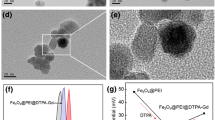Abstract
Plate-shaped Gd2O3 nanoclusters (GNCs) with well-controlled loading were fabricated by using amphiphilic poly(maleic anhydride-alt-1-octadecene) (PMAO) grafted with PEG as nanogel. The hydrodynamic size of the obtained GNCs was well controlled to <260 nm under appropriate emulsion process conditions and they showed excellent long-term dispersibility in phosphate buffer saline. MRI measurements clearly indicated the substantial improvement in T1 effect of the nanoclusters as compared with the individual Gd2O3 nanoplates. The obtained GNCs possessed a high r1 value of 7.948 s−1mM−1 [Gd], which is 2.23 times higher than that of the commercial product Gd-DOTA, and low r2/r1 of 1.04. In vitro test of the obtained GNCs was demonstrated in NIH/3T3 cell lines, and clear T1-weighted images were obtained. Thus, the PMAO-g-PEG assisted GNCs were potentially useful for T1-weighted MRI contrast agents.








Similar content being viewed by others
References
C.H. Reynolds, N. Annan, K. Beshah, J.H. Huber, S.H. Shaber, R.E. Lenkinski, and J.A. Wortman: Gadolinium-loaded nanoparticles: New contrast agents for magnetic resonance imaging. J. Am. Chem. Soc. 122, 8940 (2000).
G.H. Lee, Y. Chang, and T.J. Kim: Blood-pool and targeting MRI contrast agents: From Gd-chelates to Gd-nanoparticles. Eur. J. Inorg. Chem. 2012, 1924 (2012).
J.Y. Park, M.J. Baek, E.S. Choi, S. Woo, J.H. Kim, T.J. Kim, J.C. Jung, K.S. Chae, Y. Chang, and G.H. Lee: Paramagnetic ultrasmall gadolinium oxide nanoparticles as advanced T1 MRI contrast agent: Account for large longitudinal relaxivity, optimal particle diameter, and in vivo T1 MR images. ACS Nano 3, 3663 (2009).
K.R. Burnett, G.L. Wolf, H.R. Shumacher, Jr., and E.J. Goldstein: Gadolinium oxide: A prototype agent for contrast enhanced imaging of the liver and spleen with magnetic resonance. Magn. Reson. Imaging 3, 65 (1985).
L. Faucher, Y. Gossuin, A. Hocq, and M.A. Fortin: Impact of agglomeration on the relaxometric properties of paramagnetic ultra-small gadolinium oxide nanoparticle. Nanotechnology 22, 295103 (2011).
J.L. Bridot, A.C. Faure, S. Laurent, C. Riviere, C. Billotey, B. Hiba, M. Janier, V. Josserand, J.L. Coll, L. Vander Elst, R. Muller, S. Roux, P. Perriat, and O. Tillement: Hybrid gadolinium oxide nanoparticles: Multimodal contrast agents for in vivo imaging. J. Am. Chem. Soc. 129, 5076 (2007).
K.M.L. Taylor, J.S. Kim, W.J. Rieter, H. An, W. Lin, and W. Lin: Mesoporous silica nanospheres as highly efficient MRI contrast agents. J. Am. Chem. Soc. 130, 2154 (2008).
T. Kim, E. Momin, J. Choi, K. Yuan, H. Zaidi, J. Kim, M. Park, N. Lee, M.T. McMahon, A. Quinones-Hinojosa, J.W. Bulte, T. Hyeon, and A.A. Gilad: Mesoporous silica-coated hollow manganese oxide nanoparticles as positive T1 contrast agents for labeling and MRI tracking of adipose-derived mesenchymal stem cells. J. Am. Chem. Soc. 133, 2955 (2011).
H. Kobayashi, S. Kawamoto, T. Saga, N. Sato, T. Ishimori, J. Konishi, K. Ono, K. Togashi, and M.W. Brechbiel: Avidin-dendrimer-(1B4M-Gd)(254): A tumor-targeting therapeutic agent for gadolinium neutron capture therapy of intraperitoneal disseminated tumor which can be monitored by MRI. Bioconjugate Chem. 12, 587 (2001).
H. Kobayashi, S. Kawamoto, M. Bernardo, M.W. Brechbiel, M.V. Knopp, and P.L. Choyke: Delivery of gadolinium-labeled nanoparticles to the sentinel lymph node: Comparison of the sentinel node visualization and estimations of intra-nodal gadolinium concentration by the magnetic resonance imaging. J. Control Release 111, 343 (2006).
M.A. Fortin, R.M. Petoral, F. Soderlind, A. Klasson, M. Engstrom, T. Veres, P.O. Kall, and K. Uvdal: Polyethylene glycol-covered ultra-small Gd2O3 nanoparticles for positive contrast at 1.5 T magnetic resonance clinical scanning. Nanotechnology 18, 395501 (2007).
J.L. Bridot, D. Dayde, C. Riviere, C. Mandon, C. Billotey, S. Lerondel, R. Sabattier, G. Cartron, A. Le Pape, G. Blondiaux, M. Janier, P. Perriat, S. Roux, and O. Tillement: Hybrid gadolinium oxide nanoparticles combining imaging and therapy. J. Mater. Chem. 19, 2328 (2009).
A.G. Macedo, M.A. Martins, S.E.M. Fernandes, A. Barros-Timmons, T. Trindade, L.D. Carlos, and J. Rocha: Luminescent SiO2-coated Gd2O3:Eu3+ nanorods/poly(styrene) nanocomposites by in situ polymerization. Opt. Mater. 32, 1622 (2010).
E.N.M. Cheung, R.D.A. Alvares, W. Oakden, R. Chaudhary, M.L. Hill, J. Pichaandi, G.C.H. Mo, C. Yip, P.M. Macdonald, G.J. Stanisz, F. van Veggel, and R.S. Prosser: Polymer-stabilized lanthanide fluoride nanoparticle aggregates as contrast agents for magnetic resonance imaging and computed tomography. Chem. Mater. 22, 4728 (2010).
W.W. Yu, E. Chang, C.M. Sayes, R. Drezek, and V.L. Colvin: Aqueous dispersion of monodisperse magnetic iron oxide nanocrystals through phase transfer. Nanotechnology 17, 4483 (2006).
Y.C. Cao: Synthesis of square gadolinium-oxide nanoplates. J. Am. Chem. Soc. 126, 7456 (2004).
J. Paek, C.H. Lee, J. Choi, S.Y. Choi, A. Kim, J.W. Lee, and K. Lee: Gadolinium oxide nanoring and nanoplate: Anisotropic shape control. Cryst. Growth Des. 7, 1378 (2007).
S.V. Mahajan and J.H. Dickerson: Synthesis of monodisperse sub-3 nm RE2O3 and Gd2O3:RE3+ nanocrystals. Nanotechnology 18, 325605 (2007).
M.J. Park, J. Park, T. Hyeon, and K. Char: Effect of interacting nanoparticles on the ordered morphology of block copolymer/nanoparticle mixtures. J. Polym. Sci., Part B-Polym. Phys. 44, 3571 (2006).
F. Soderlind, H. Pedersen, R.M. Petoral, Jr., P-O. Kall, and K. Uvdal: Synthesis and characterisation of Gd2O3 nanocrystals functionalised by organic acids. J. Colloid Interface Sci. 288, 140 (2005).
G.K. Das, B.C. Heng, S-C. Ng, T. White, J.S.C. Loo, L. D’Silva, P. Padmanabhan, K.K. Bhakoo, S.T. Selvan, and T.T.Y. Tan: Gadolinium oxide ultranarrow nanorods as multimodal contrast agents for optical and magnetic resonance imaging. Langmuir 26, 8959 (2010).
ACKNOWLEDGMENTS
This work is supported by the MOE’s ARF Tier 1 funding WBS R-284-000-102-112 (National University of Singapore, Singapore).
Author information
Authors and Affiliations
Corresponding author
Supplementary Material
Rights and permissions
About this article
Cite this article
Yuan, J., Peng, E. & Xue, J.M. Controlled loading of paramagnetic gadolinium oxide nanoplates in PMAO-g-PEG as effective T1-weighted MRI contrast agents. Journal of Materials Research 29, 1626–1634 (2014). https://doi.org/10.1557/jmr.2014.185
Received:
Accepted:
Published:
Issue Date:
DOI: https://doi.org/10.1557/jmr.2014.185




